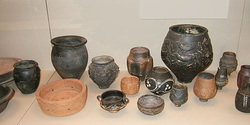Religious Rituals in Cities
In the 1st wave civilizations, people tended to stick with their polytheistic religions. Beliefs that people were influenced by all aspects of nature, but it seems like this never was such a focus in the cities. The most common ritual sight was public sacrifice of people for the gods, however, second wave civilizations had more various religions with more sophisticated beliefs. Sure, a lot of sacrificial ceremonies still happened, but in many of the cities this was lessened. The ideas of monotheism (Judaism) emerged during this time, and it was encouraging being a good person. Different belief systems also emerged, like Doaism and Legalism which are not religions, but affect how people worked in their cities.
Religion tended to be more of a present feature in culture in China, Rome, Persia, and South America.
The general rule was that religion becamse an integral part of the cultures, religion tended to be more sophisticated than in first waves, and that people were questioning polytheism more than before. The exception to the rule is Teotihuacan, which developed at the same time as the second waves, but resembles the first waves more in it's amount of human sacrifice and such. More information on Teotihuacan can be found in the case study.
Religion tended to be more of a present feature in culture in China, Rome, Persia, and South America.
The general rule was that religion becamse an integral part of the cultures, religion tended to be more sophisticated than in first waves, and that people were questioning polytheism more than before. The exception to the rule is Teotihuacan, which developed at the same time as the second waves, but resembles the first waves more in it's amount of human sacrifice and such. More information on Teotihuacan can be found in the case study.
Specific Cities

Roman Pottery with Gods on it
Rome is a good example of religious rituals affecting cities and being involved. They are an example that is polytheistic, but is more forward than sacrificing people. The religion to the Romans was Hellenism (taken from the Greek. The people from Rome were all about conquest, heroes, and the ideas of having fun, they had an infatuation, while being afraid of human sacrifice. The Religious rituals we see with Rome tend to revolve around conquest and the idea of becoming a hero like those in legend. They would spread their religion by conquering and making their culture the main one of the areas. For them, religion was their culture and everything about Romans (other than their political system) that we identify. The whole Zeus, Hercules, Poseidon concept comes from them, and they are all religious figures. Their religious document also acted as entertainment at some points, where the Iliad or Odessey were read aloud to the people around.
Another good example for this is in the rural areas of Han China with the Mandate of Heaven. It was highly believed that the gods would hand pick the leader for the area, however, if the people disagreed, the person clearly fell out of favor with the gods. Also in China were the ideas of Daoism and Legalism. Both of these ideas were complete polar opposites. Daoists were all about nature and the idea of going with the flow, so in cities where this would happen, the people would generally be less developed. But, more involved in cities, is Legalism. This was the government system where people were not supposed to be like themselves, they were supposed to be drones for the government. There were no real rituals here, other than forcing people to follow these "religious" ideas in order to gain status.
Another good example for this is in the rural areas of Han China with the Mandate of Heaven. It was highly believed that the gods would hand pick the leader for the area, however, if the people disagreed, the person clearly fell out of favor with the gods. Also in China were the ideas of Daoism and Legalism. Both of these ideas were complete polar opposites. Daoists were all about nature and the idea of going with the flow, so in cities where this would happen, the people would generally be less developed. But, more involved in cities, is Legalism. This was the government system where people were not supposed to be like themselves, they were supposed to be drones for the government. There were no real rituals here, other than forcing people to follow these "religious" ideas in order to gain status.
Persia was a bit different compared to the other groups in terms of the religion because it had no singular one. This makes it the outcast to think about when cities are talked about. They allowed religious freedom, meaning almost everything was okay.

